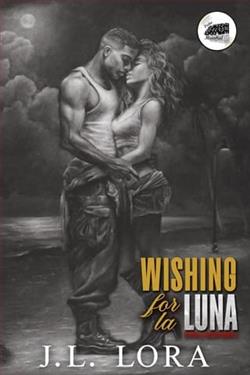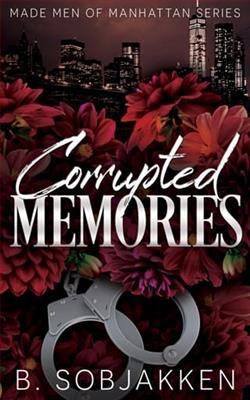Page 19 of Casanova LLC
Claire
I didn’t have to wait until the following week to find Alessandro’s paintings. Caroline and I found them the following day, not in one of the myriad warehouses, but in my building’s garage when I was showing her the cars. We were looking at the Phantom and I remembered that the storage cage next to it belonged to us, too. It wasn’t even locked.
I walked in and saw remnants of my past, both with Richard and mine alone. The bike I used to ride around the city before I met him. Christmas decorations from our yearly who’s-who party. My old Art History textbooks. Random items—things, stuff—still in their original packaging; never opened, never used. And Alessandro’s paintings.
They weren’t crated. They weren’t wrapped in plastic sheeting. They weren’t cared for or cared about. They were just stacked, haphazard tiles, on the concrete floor.
“More art?” Caroline asked, sounding like someone had ordered another bottle of champagne.
If only I hadn’t come down here with her in tow. She would have never known they existed. I could have shipped them to Alessandro and been done with all of it.
Caroline had already begun unstacking them, checking for damage. Remarkably, there wasn’t any. “They’re nice. Do you know the artist?”
I shook my head. The man you drooled over two days ago didn’t seem a warranted response. Besides, let Sotheby’s do the leg work. Let them earn the ten percent commission I’d be paying to buy them back. “I’ll clear it out.” I wanted her to stop hovering over everything, over me, like a crow at a dumpster.
She went back to the cars. I could tell she enjoyed them. Opening and closing doors, sliding in and out. She took a selfie in the Lamborghini when she thought I wasn’t paying attention.
I wasn’t. My focus was on the paintings. I brought them out of the cage one by one. Lined them up against the chain-link like suspects. My phone’s flashlight trained on them, an interrogation.
God. He really was talented.
He played with perspective. That was his signature. A crystal-clear near photorealism up front that drifted slowly into an impressionistic blur. Or he would reverse it. Most of them were Venetian scenes. Bridges, cafés, gondolas, Carnival. Among the landscapes, there were two portraits. A delicate middle-aged woman asleep on a velvet chaise. And a debonair-looking man reading by a fire with a carafe of wine next to him. There was something familiar about him, as though he were about to get up and offer me a glass. Maybe it was just the way Alessandro breathed life into his subjects.
I’d first seen his work at a studio I frequented. I was friendly with the owner, Cyril, who supplied most of the Brooklyn art world with its paints. I was there, as I often was then, perusing his catalogs of color, trying to nail down the complementary palettes for my burgeoning makeup line. The line that would become Visage. I’d been looking for a particular shade of rose and Cyril had taken me around the corner to the open studio, where artists paid him a monthly fee for easel space, where one particular painting was set up and?—
It hit me, why the man in the painting was familiar. He’d been with Alessandro at the gallery that night. At my rehearsal dinner.
This was the way of my brain these days. Everything on delay and a multitude of trajectories all at once. An airport during a winter storm two days before Christmas.
Anyway. The painting on the easel: a view of the Grand Canal through a Moorish-style window at golden hour. As Cyril pointed out the rose hue of the building on the left border, I felt my entire being pulled toward the scene. Toward the feeling it evoked. A tugging. A longing.
I’d even started crying.
It hadn’t been a full-on Stendhal episode, but it was close.
I’d snapped a picture and that night, waiting for Richard at Per Se, I studied it. Zoomed in and out. I wanted to understand how he had accomplished it, the magic that overshadowed the technique.
When Richard had finally shown, I’d walked him through my, at that point, dissertation-level analysis of the work. He nodded along. Yes, the technique was good, but untested. It, and the artist, required seasoning. The thing was, I didn’t care. I’d been moved. Deeply. Intimately. Like no other painting I had ever seen. So what if it wasn’t perfect? I’d never believed in perfection anyway. That was Richard’s thing.
He shrugged that off. He told me it was old-school classical with a kitschy flair. Tons of artists would have been the creme de la creme of the Royal Academy two hundred years ago, but that wasn’t the market.
The market was what Richard knew. It was the only reason he bought. It didn’t matter how art made you feel, it didn’t even matter if you liked it. It only mattered how much it cost now and how much it would cost later.
We agreed to disagree, as usual. He knew how I felt about art; I knew how he didn’t feel about art. We’d met at a gallery, after all. When I’d been interning as the wine-and-cheese girl and he’d been the buyer everyone tiptoed around and kowtowed to and whispered about. The Kingmaker. Midas of the art world. Eventually I worked my way up and two years later I was managing the gallery. The gallery with the art I secretly hated. The gallery where I sold as much as I could just to get it out of my sight. The gallery where, eventually, I was acquired by Richard Craven, too. Where we’d had our rehearsal dinner. Where I’d met Alessandro.
I turned away from these thoughts, and back to the paintings.
To the man himself.
To his hands, his eyes, his mind. All of which had made these. Conjured them. Was this the artistry he brought to women? Did to them what he did to a blank canvas?
The tugging was back. The longing.
What do you long for? he’d asked.
When, Claire? When did you last feel longing?
Had you longed for Richard in those first heady weeks of dating? When he’d turned the vast power of his attention on you? When he’d proposed a year later? When you’d realized there wasn’t room for the both of you in the art world? When you’d decided to become a businesswoman so you wouldn’t become a trophy wife? When he put you on a shelf anyway?















